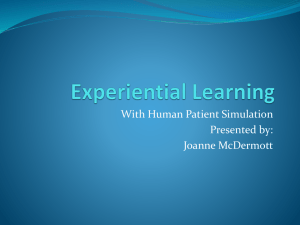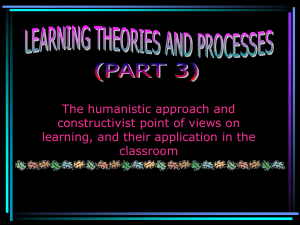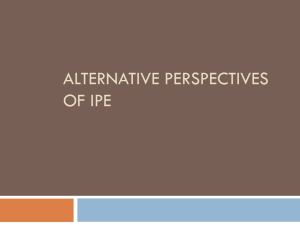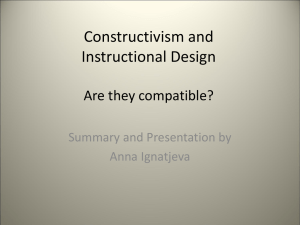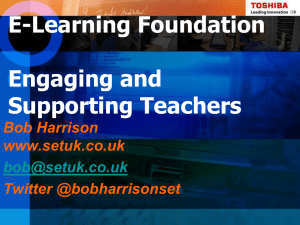paper
advertisement
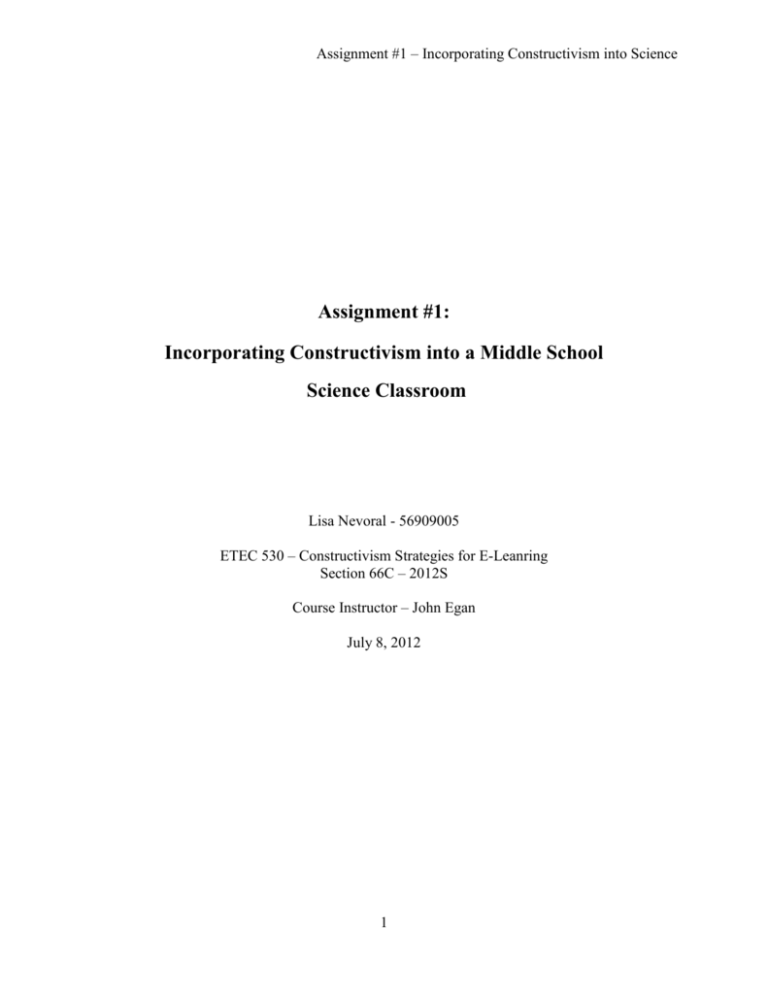
Assignment #1 – Incorporating Constructivism into Science Assignment #1: Incorporating Constructivism into a Middle School Science Classroom Lisa Nevoral - 56909005 ETEC 530 – Constructivism Strategies for E-Leanring Section 66C – 2012S Course Instructor – John Egan July 8, 2012 1 Assignment #1 – Incorporating Constructivism into Science Many middle school science teachers still continue to use the traditional methods of instructional delivery that are very teacher-centered and content-based. With the rise of such educational ideas as the 21st Century Learner, this pedagogy is not helping our students attain the skills involved to be this type of learner. As well, gone are the days where the teacher and a science textbook are the only sources of information for a learner to use. With the rapid increase and influx of different technological tools, such as computers and mobile devices, learners have an inconceivable amount of information readily available at their fingertips. Incorporating constructivist theories and practices into a science classroom has been a long process. A current version of the science classroom has tried to meld teacher-centered instruction with hands-on activities. But these activities are heavily guided so that students obtain all the same outcomes. Science teachers are starting to see the worth of incorporating more student-centered, collaborative learning opportunities into their classrooms. There has been a shift in pedagogical strategies that utilizes cooperative group learning and authentic problems which helps motivate students and fosters critical thinking skills. It is for these reasons that I have started to develop a constructivist attitude in my science classes. What is Constructivism? The premise behind constructivism is that individual learners need to construct their own meaning of knowledge by building upon previous knowledge and by learning through collaboration with others. A transformation of knowledge occurs when a learner is able to reconcile what is been taught with their existing knowledge while being entrenched within the cultural and social contexts in which the ideas were formed (Windschitl, 1999). This social 2 Assignment #1 – Incorporating Constructivism into Science aspect of learning may help individuals gain insight on ideas that they would not have thought about by themselves; it gives them different points of views, helps fill in gaps, and helps solidify their own thoughts. As well, students learn to articulate what they are trying to get across when exchanging ideas. Students learn more when they are actively engaged and take ownership over what they are learning. A learner needs to create, interpret, and reorganize knowledge in individual ways and cannot be a passive receiver of knowledge, but an active constructor of it (Duit, 1996; Windschitl, 1999). To do this, they must seek out information, analyze it, and reflect upon their learning so that the individual can construct his or her own ideas about science and how it relates to the world. The new knowledge must be viable and allow the individual to connect what is being learned with their everyday experiences (Duit, 1996). As educators, it is imperative to check if individuals’ prior knowledge is correct and to build upon their knowledge through scaffolding, coaching, and mentoring. In science education, learners have many prior conceptions that strongly influence the acquirement of new knowledge and the learners’ problem solving behaviour. Teachers must be able to detect the misconceptions learners have and help the learner construct a new understanding of the world around them (Kolonder et al., 2003). What does the Science Classroom Look Like? In a typical science classroom, the teacher stands at the front of the class, gives a lecture or presentation, and then has the students work individually on identical, skill based assignments 3 Assignment #1 – Incorporating Constructivism into Science to ensure uniformity of learning (Windschitl, 1999). More times than not, critical thinking, collaborative skills, and student reflection are overlooked and many of the problems and experiments are prescriptive with only one outcome (Scott, 1994). I can say that I have been guilty of teaching in this manner, although I have used multimedia and a variety of activities in my science lessons to try and meet the needs of different learning styles. As well, I have tried to enhance my teaching of science by integrating project-based learning, open-ended problems, and cooperative group work throughout the school year. This type of learning opportunity allows for variation in lessons and is intended to balance teacher-directed lectures and demonstrations with individual and group tasks ranging from prescriptive to open-ended. Although I believe this is a step in the right direction it is not tapping into the most important resource; the innate curiosity of the learner (Scott, 1994). As Kolonder et al. (2003) suggests, we need to provide students with science knowledge in such a way that they understand not only the science concepts and principles by learning definitions and formulas, but also relate them to real-life, everyday experiences. Gone are the days of rote learning and regurgitation of facts; we need students to practice problem solving and make decisions to fully grasp the information in which they are being exposed to. The teacher should not and cannot be the sole source of this information. With the use of technology, collaborative learning, and other resources, students can start to create their own knowledge about these facts. Science instruction should focus on the students, their interests, and their learning skills (Ross & Willson, 2012). 4 Assignment #1 – Incorporating Constructivism into Science What is the Role of the Teacher in a Science Classroom that uses Constructivist Strategies? The teacher using constructivist strategies now has a different role then they have ever had before. They must step back from being the sole content-giver and provider of all the answers to being a facilitator, helping create an environment of collaboration and critical thinking (Krajcik, Blumenfeld, Marx, & Soloway, 1994). In order to do this, teachers must now oversee classroom and group discussions, help guide students with probing questions or suggestions, and provide advice, support, and feedback to help push students in their knowledge construction. This is especially critical with middle school students since they don’t always make the connection between what they know, what they need to know, and what they are learning. “We can no longer be satisfied with the “right answers” on tests, tidy well run labs, or beautifully designed, carried-out and presented science projects” (Scott, 1994) Science knowledge is not an abstraction that can be readily transferred from how it is learned in the classroom to how it is used outside school (Marx, Blumenfeld, Krajcik, & Soloway, 1997). Knowledge acquisition and growth needs to be contextualized and cannot be easily separated from the situation in which it is developed; therefore knowing and doing cannot be separate and learning needs to be an active process. Teachers who use constructivist strategies now have the task of creating problems and projects that are authentic in nature and in a context that students can relate them to their real-life experiences (Kolonder et al., 2003). Cooperative Learning in the Science Class Cooperative learning is a very useful constructivist strategy. It not only allows students to work in groups, but it develops skills such as negotiation, cooperation, accountability, and 5 Assignment #1 – Incorporating Constructivism into Science reflection. Groups created with cooperative learning in mind are very structured and should be heterogeneous, allowing students to encounter many different perspectives and styles of thinking (Kolonder et al., 2003). In this social context, learning can be achieved through collaboration, negotiated meaning and distributed expertise (Krajcik et al., 1994). Teamwork is more than a collection of individuals doing similar activities (Scott, 1994). Instead, the group is working towards a common goal and specific tasks are assigned to each student to complete for the group to see success. This gives students a sense of ownership over the problems, activities, and their own learning. To see full benefits, students within a group need to care about one another’s achievements and learning. Challenges and frustrations by the dynamics of interpersonal relations may arise and individuals need to find a balance between individual and group identities (Scott, 1994). A teacher’s role is to help smooth out any rough patches that may occur, providing advice and guidance. Project-Based Learning in the Science Class Science is seen by many students as ambiguous and not related at all to their everyday experiences. Project-based learning (PBL) stimulates and engages students to be challenged with tasks that resemble authentic science problems and helps them connect what they learn in class with real life. Students have an active role in their knowledge acquisition and PBL helps create learners capable of life-long learning instead of rote memorization of facts (Krajcik et al., 1994). The use of cognitive tools, such as computers, can help learners solve complex and “illstructured” problems by providing access to information, as well as opportunities to collaborate, investigate, and create artifacts (Krajcik et al., 1994). In addition, learners are working to gain 6 Assignment #1 – Incorporating Constructivism into Science new knowledge by utilizing prior knowledge and PBL affords them the chances to come up with what they need to know in order to discover the answers. There are several important aspects for incorporating PBL into a science class. A teacher needs to create a driving question that is viable and allows for multiple representations of knowledge acquisition (Krajcik et al., 1994; Scott, 1994). The problem created has to be authentic and substantial and can be related to the students’ lives and their everyday experiences (Scott, 1994; Marx et al., 1997). Finally, a project must utilize collaboration and cooperative group work. Students’ thinking and learning is continuously affected by the input of others due to the fact that there is a broader range of perspectives. Why isn’t Constructivism being used extensively in Science Classrooms? Although I see much value in teaching using constructivist strategies, there are several reasons why it might not be used extensively in the science classroom. Many teachers have used a transmission mode of pedagogy for years and might find it daunting to relinquish some of their control over how they manage the classroom. They may now be in classes where they will need to maintain order so that students obtain results that are needed, but allow students to seek their own understanding of the information. Herreid (1998) states that cooperative learning puts more emphasis on problem solving and critical thinking than learning all of the course content or material. That, along with claims that not enough of the curriculum can be covered if teachers do not lecture, may prevent some teachers in converting their pedagogical ways. In addition, it takes a teacher a lot of time and 7 Assignment #1 – Incorporating Constructivism into Science effort to collaborate with other teachers, design good problems or projects, devise new assessment tools, and attend professional development opportunities to implement constructivist strategies into their lessons. Not all challenges associated with a constructivist classroom are teacher related. Sometimes, not all students “buy into” managing their own learning or working in groups. In this regard, teachers need to spend time persuading those students on the benefits to their learning using the implemented strategies. As well, novice learners may not have the prior knowledge to help them learn new information because they don’t have the background upon which to construct new meaning of the learned material. Some students will still chose the quickest route through instruction or activities, even with the best laid plans by the teacher. Additionally, allowing students to construct their own learning takes time. Some students may get the idea right away while others need more time. Conclusion Incorporating constructivist strategies into a science class will require major changes in curriculum, in scheduling, and in assessment and it will take a lot of hard work, time, and preparation. Windschitl (1999) suggests that the only way to overcome many of the challenges associated with a shift in pedagogy is with proper scaffolding in the form of access to professional development, support from peers, and the use of technology. Even with the numerous challenges, there are many great reasons why constructivist strategies such as cooperative learning and project-based learning should be used in the classroom. Teachers do not have all the answers and through collaboration and actively engaging our students will we 8 Assignment #1 – Incorporating Constructivism into Science see them construct their own meaning and connections. We must also prepare our students for the 21st century, where technology is quickly evolving and future employers are looking to hire people with transferable skills and critical thinking abilities. 9 Assignment #1 – Incorporating Constructivism into Science References Duit, R. (1996). The Constructivist View in Science Education – What It Has to Offer and What Should not be Expected. Investigacoes em Ensino de Ciencias, 1(1), pp. 40-75. Herreid, C.F. (1998). Why Isn't Cooperative Learning Used to Teach Science? BioScience, 48(7), pp. 553-559. Kolodner, J.L., Camp, P.J., Crismond, D., Fasse, B., Grau, J., Holbrook, J., Puntambekar, S., and Ryan, M. (2003). Problem-Based Learning Meets Case-Based Reasoning in the Middle-School Science Classroom: Putting Learning by Design™ into Practice. The Journal of the Learning Sciences, 12(4), pp. 495-547. . Krajcik, J.S., Blumenfeld, P.C., Marx, R.W., and Soloway, E. (1994). A Collaborative Model for Helping Middle Grade Science Teachers Learn Project-Based. The Elementary School Journal, 94(5), pp. 483-497. Marx, R.W., Blumenfeld, P.C., Krajcik, J.S., and Soloway, E. (1997). Enacting Project-Based Science. The Elementary School Journal, 97(4), pp. 341-358. Matthews, M.R. (1993). Constructivism and Science Education: Some Epistemological Problems. Journal of Science Education and Technology. 2(1), pp. 359-370. Ross, A; Willson,V. (2012). The Effects of Representations, Constructivist Approaches, and Engagement on Middle School Students’ Algebraic Procedure and Conceptual Understanding. School Science and Mathematics, 112(2), pp. 112-128. Scott, C.A. (1994) Project-Based Science: Reflections of a Middle School Teacher. The Elementary School Journal, 95(1), pp. 75-94. Windschitl, M. (1999). The Challenges of Sustaining a Constructivist Classroom Culture. The Phi Delta Kappan, 80(1), pp. 751-755. 10




